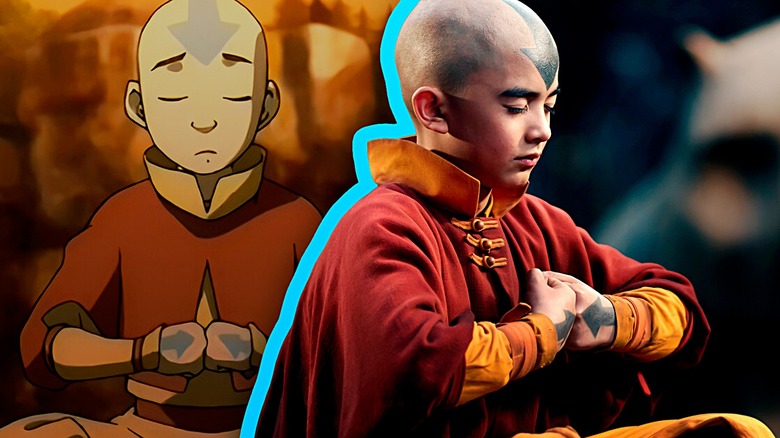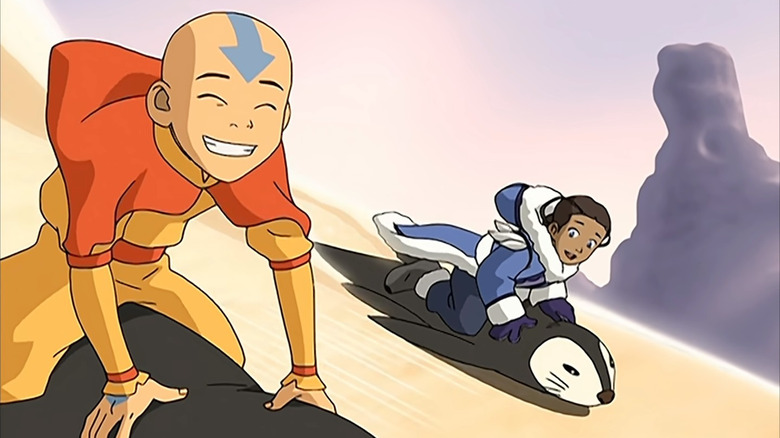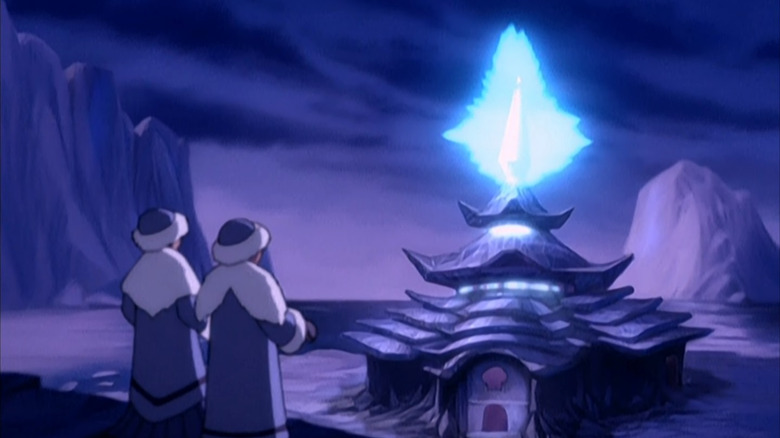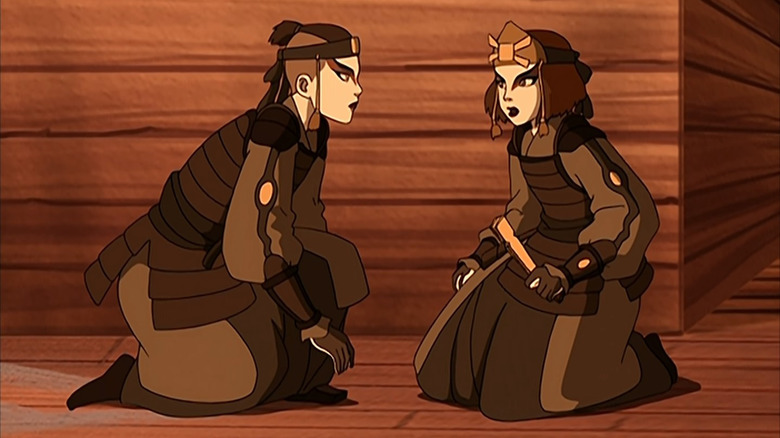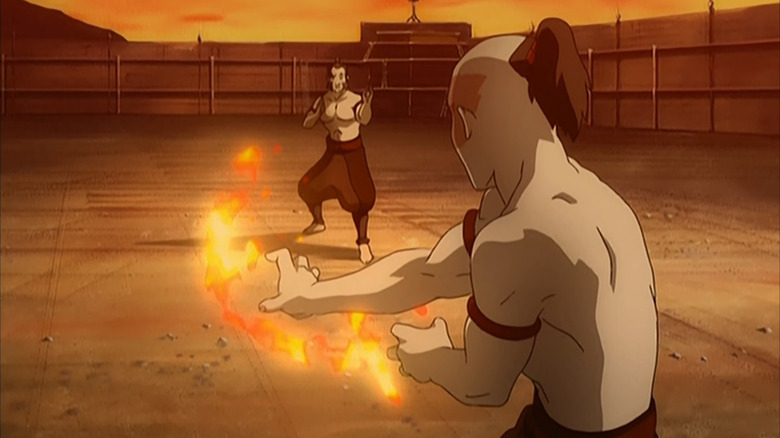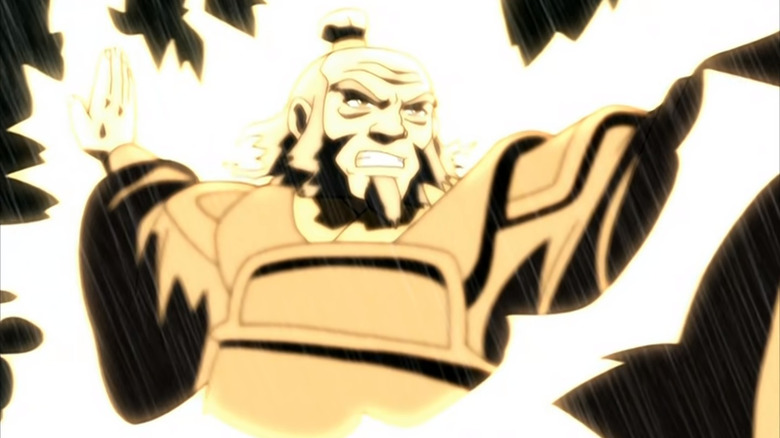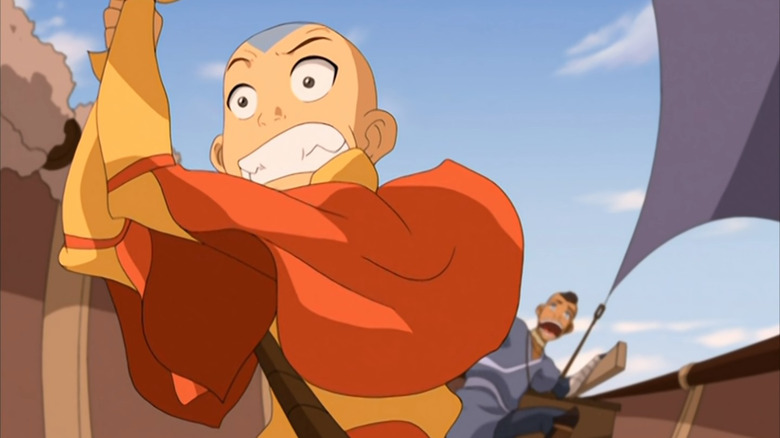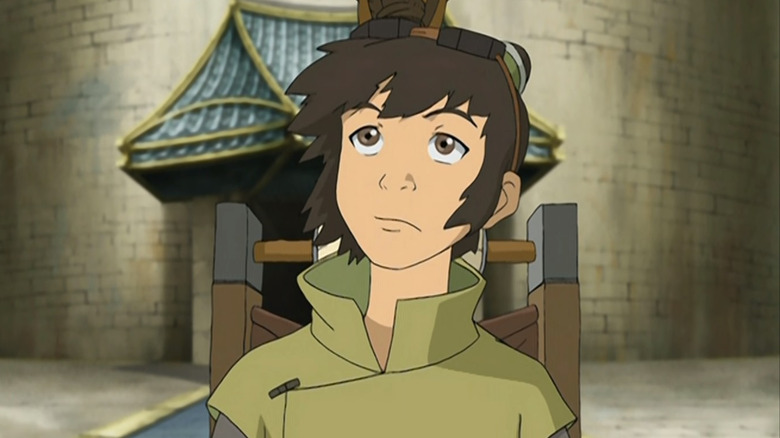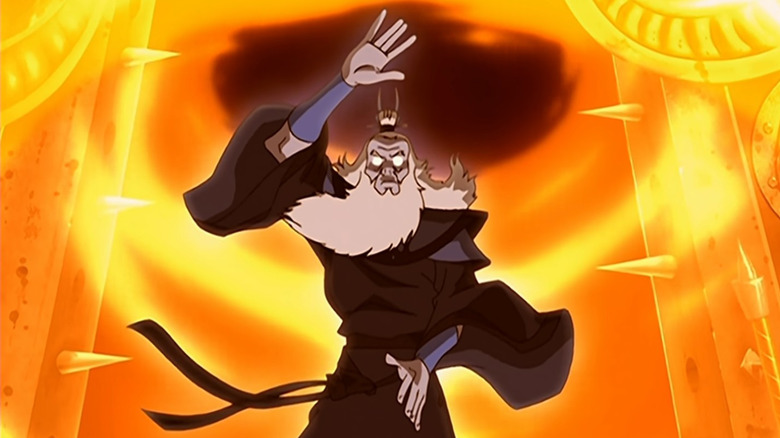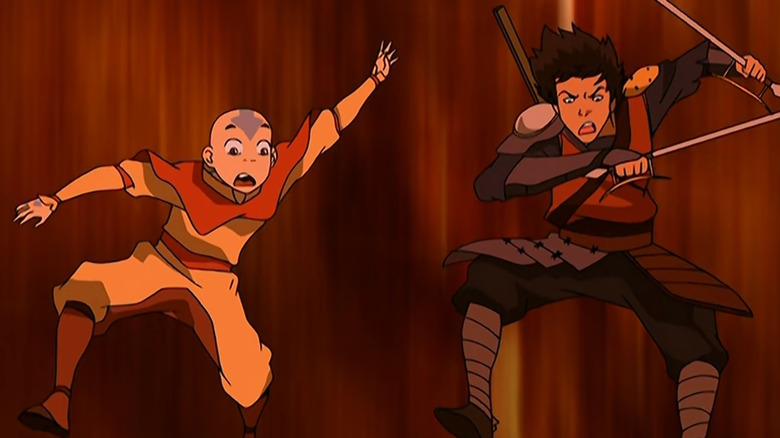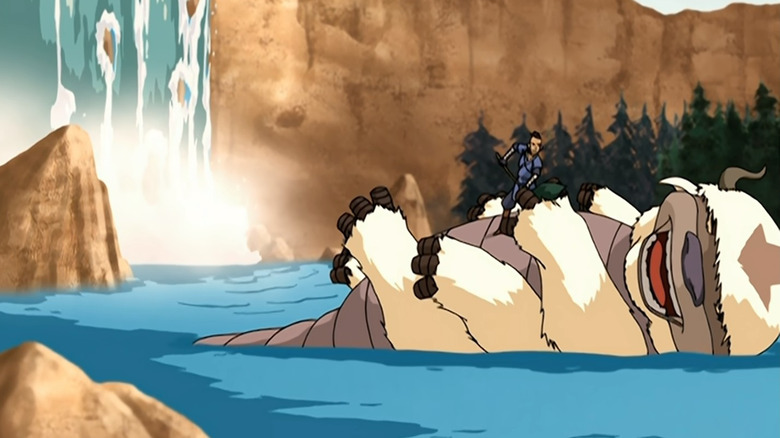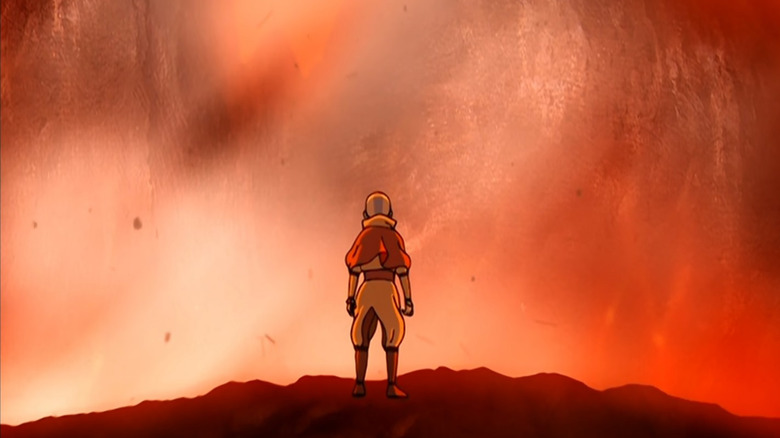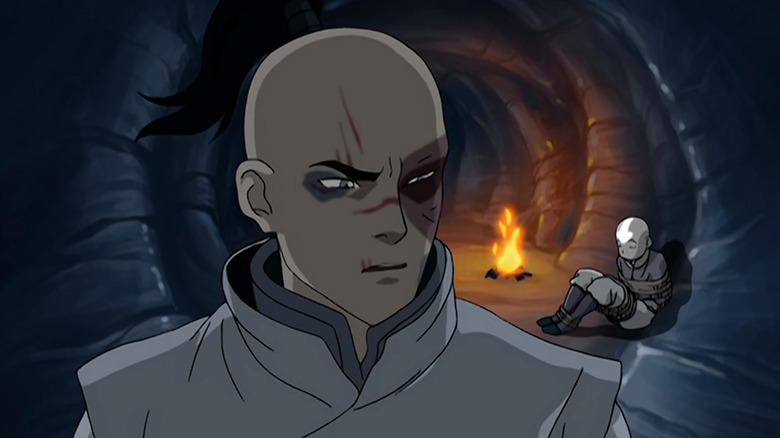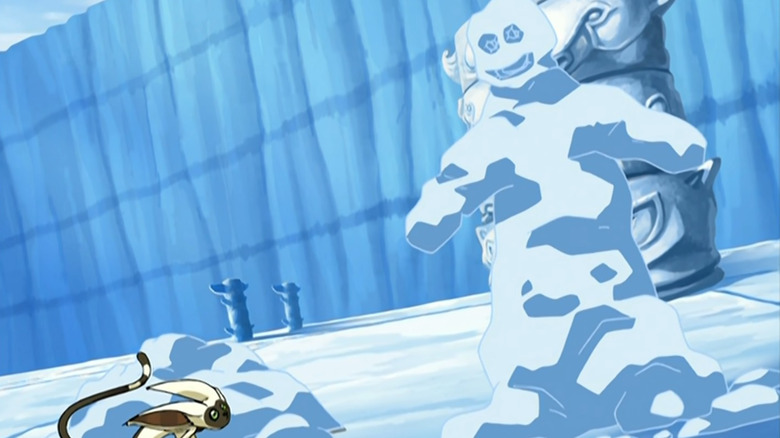Netflix's Avatar: The Last Airbender Shouldn't Have Cut These Anime Scenes
Contains spoilers for "Avatar: The Last Airbender"
After years of anticipation, Netflix's live-action "Avatar: The Last Airbender" adaptation is finally here, and the reception from fans and critics has been somewhat mixed. The cast, costuming, fight choreography, and special effects have all received extensive praise, but the series has earned criticism for pacing problems, tonal inconsistency, and odd writing choices.
It would be insulting to compare the new series to M. Night Shyamalan's infamous 2010 film, but it still falls dramatically short of the original. Fortunately, there are enough changes and stylish moments to make it well worth watching, especially for longtime fans. Some additions, like Azula's (Elizabeth Yu) extra backstory and the inclusion of more of Aang's (Gordon Cormier) past lives, are welcome. However, the Netflix adaptation also cuts a lot of material from the cartoon. Some of these exclusions are handled well, but others leave glaring holes in the emotional patchwork of the story.
In its effort to streamline the series, we lose out on playful bonding, key fights, and emotional moments. Netflix's "Avatar: The Last Airbender" shouldn't have cut these animated scenes, and this is why.
Penguin sledding
If there's one overriding issue with Netflix's "Avatar: The Last Airbender," it's that the first six episodes run at a breakneck pace. In the interest of time, and to help things coexist within much longer episodes, the show blends a lot of arcs that take place separately in the cartoon. It also speeds through key story beats like Aang's time in the South Pole. In the new version, he barely has time to talk to Katara (Kiawentiio) or Sokka (Ian Ousley) before Zuko (Dallas Liu) arrives and takes him away.
In the original, Aang's first question to Katara is a simple one: "Will you go penguin sledding with me?" It's an immediate indicator of his playful nature, and the scene of them shooting down the ice on the backs of otter-penguins is one of the show's most iconic. "I haven't done this since I was a kid," Katara says on the ride, laughing. "You still are a kid," Aang reminds her.
This is a core facet of Aang and Katara's relationship — her hard life has forced her to grow up too quickly, and Aang reminds her constantly that she's still allowed to be a 14-year-old girl. While the live-action series gives the two a few playful moments, it misses this foundational scene, and it takes a while for the Netflix version to start cashing in on their chemistry.
The Avatar returns
In the live-action version of "Avatar," Prince Zuko is alerted to Aang's awakening both when he sees the light sent off from the iceberg, and also when his collection of Avatar statues begins to glow. It's a nod to a scene from the cartoon in which statues around the world start glowing because of Aang's return. Unfortunately, that original scene never happens in the live-action series.
The animated sequence hits hard in two ways. First, it gives a more epic tone to Aang's grief-stoked Avatar State episode at the Southern Air Temple, adding global consequences to his own personal anguish. Secondly, it makes the Avatar's return a huge event — one recognized around the world by all kinds of people. This montage sets the stage for how Aang is treated as he moves through the Earth Kingdom, and it helps emphasize just how monumental this point in time is for the world.
Of all the entries on this list, this isn't the biggest loss. Still, it would have been cool to see, especially given how many shrines Aang visits later and how Zuko's statues reflect his return. Adding in a more global effect wouldn't have taken much more screen time, but perhaps there were other production decisions at play. Regardless, word of Aang's return makes its way out — just more slowly than in the original.
Suki and Sokka's original kiss
In the days leading up to the release of Netflix's "Avatar: The Last Airbender," much was made of a key change to Sokka. In pre-release interviews, members of the cast and crew stated that they played down the sexism he shows at the beginning of the original show, which manifests primarily in his visit to Kyoshi Island. Sokka indeed comes off as less problematic in the live-action version, but that doesn't necessarily make it better.
His animated arc with Suki is brief but pivotal. He comes to fully acknowledge his arrogance and misogyny and asks her to teach him, even putting on the full dress to train. A version of this happens in the new show, but it's more focused on the sexual tension than an actual lesson in humility. Suki, for her part, is played fantastically by Maria Zhang, but the character is written much stiffer than her animated counterpart.
It's unsurprising, then, that the live-action series skips the big climax of Sokka and Suki's first episode. In the cartoon, as Zuko attacks the village, Sokka pulls Zuko to the side and apologizes for his crudeness. "I treated you like a girl when I should have treated you like a warrior," he says. "I am a warrior," Suki says, and kisses him. "But I'm a girl, too." It's a nuanced moment that Zhang could have nailed, but unfortunately, she doesn't get the chance.
Zuko and Zhao's Agni Kai
Admiral Zhao is a lot different in the live-action "Avatar" than he is in the original series, but Ken Leung plays the part spectacularly. He turns the staunch brutality of Jason Isaacs' animated character into a conniving snake, and it works quite well. For this reason, though — or perhaps simply for the sake of time — the Netflix adaptation cuts one of the best fights of Season 1: The Agni Kai between Zhao and Prince Zuko.
Until Zuko and Azula started sparring in later seasons, that fight stood as the best example of what a fire duel could look like. It's a tense, gorgeously animated battle in the original, as well as an efficient way of showing the kind of person Zuko is. He may not be the most naturally talented Firebender in the world, but there's no one more tenacious. Say, "Basics, Zuko, break his root," to any diehard "Avatar" fan and see what happens.
The live-action series covers for this absence in part by having Zuko actually fight Ozai in the Agni Kai which leads to his banishment. In the cartoon, Zuko refuses to fight his father, and Ozai burns him anyway. Netflix chooses to give us a proper father-son duel, which is pretty tense, but it's certainly not better than the Zhao vs. Zuko Agni Kai.
The Storm
Yes, "The Storm" is an entire episode of "Avatar: The Last Airbender," not just one scene. But that doesn't mean that the new series doesn't still miss it dearly. Set halfway through Season 1 of the original, "The Storm" is the first in a proud Avatarverse tradition — the slow, quiet, character development episode. As a brutal storm rages over them both, Aang and Zuko's tragic backstories are revealed. The episode ends with a gorgeous encounter and a lesson that we can all afford to be a bit kinder to ourselves.
Because Netflix is doing the whole "Game of Thrones" thing, these flashbacks are worked into other episodes, removing the need for the storm entirely. And yet, it still feels like something's missing. For one, we don't see Zuko choosing to prioritize his crew over the Avatar for once. The live-action version instead tells us that his crew comes from the 41st Division — a unit Zuko helped save from a suicide mission when he was younger. The effect is the same, but there's something about the symbolic simplicity of the storm itself that's hard to do without.
The live-action series also spends a ton of time making Aang feel guilty for his 100-year absence. It's essentially his whole arc, and it starts to get tiresome after a while. Keeping in some piece of the storm — an episode specifically designed to help Aang make peace with his actions — could have brought this arc home more smoothly.
Sokka's ice-dodging trial
One of the original "Avatar" episodes that gets cut in the Netflix version is "Bato of the Water Tribe." Elements of it are sprinkled elsewhere, with the bounty hunter June (Arden Cho) still being hired to find Aang and Bato (Trevor Carroll) appearing in a flashback. But because the main story of the animated episode is excluded, we don't get to see Sokka's ice-dodging trial.
Ice dodging is a Water Tribe rite of passage, whereby a young member of the tribe must command a crew aboard a ship sent through a field of deadly icebergs. In the live-action series, Sokka completes his ice-dodging test before his father leaves for war, though he apparently doesn't do a very good job. In the cartoon, however, Sokka is too young when the men of his tribe depart, so he completes the trial after encountering Bato recovering from injuries in the Earth Kingdom.
It's a fun scene that shows a core piece of Water Tribe culture. It also presents an important opportunity for Katara and Sokka — the chance to leave Aang and find their father instead. In the animated episode, Aang hides a message for Bato from Hakoda because he's afraid his friends will abandon him. They consider it briefly after Aang admits his deception, but they ultimately choose to forgive him and stay together. It's not a necessary moment, but it is a nice bit of extra character development that's missing in the Netflix adaptation.
A test of spirit
Teo (Lucian-River Chauhan) and his father Sai (Danny Pudi) both appear in the Netflix "Avatar: The Last Airbender" adaptation, but their story is a lot different from the cartoon. Both characters are transposed from the Northern Air Temple to Omashu, where Sai is the official mechanist for King Bumi (Utkarsh Ambudkar). Instead of being part of a whole community, they're just two refugees. Teo still has his glider chair, though.
It's understandable why the new show would want to condense multiple storylines into Omashu, but something gets lost in translation with Teo in particular. In the cartoon, Aang struggles to accept these non-Airbenders living in his people's old home and using their gliders. He's disgusted by all the changes that Sai has made to the temple, but he's ultimately won over by Teo's joy and charisma. Teo describes "something lighter than air" that takes over when he flies. "Spirit," Aang responds. "That's the 'something' you're talking about."
Though it's short, their glider race is a nice moment that isn't recreated in the new series. It's an opportunity for Aang to grapple with the ways the world has changed. In the Netflix version, Teo being able to fly is barely discussed. He's also pretty bloodthirsty for a kid when it comes to the Fire Nation — understandable, but a far cry from the character who wins Aang over in the original.
Roku sinking the temple
One of the big things that's severely downplayed in the Netflix "Avatar" is Aang's relationship with Avatar Roku (C. S. Lee). Because other past lives like Kyoshi (Yvonne Chapman) and Kuruk (Meegwun Fairbrother) play a much larger role, Roku's part isn't nearly as important. In Season 1 of the cartoon, he's the only past Avatar whom Aang has direct contact with. Here, he's not even the first.
A key moment in the animated series takes place at the end of "Winter Solstice Part 2: Avatar Roku." After communing with Roku's spirit in the heart of his temple, Aang realizes he has no way out because of the Firebenders surrounding him. Roku takes over his body, enters the Avatar State, and in a staggering display of bending mastery, basically invokes a volcanic eruption that sinks the temple.
This scene is swapped out in the live-action series for one starring Kyoshi. It's still a cool action set piece, and it makes sense given how many Kyoshi stans there are in the world now, thanks to her popular novels. Still, it's hard not to miss this moment from Roku, who's basically pushed to the side of the live-action adaptation despite being the Avatar immediately before Aang.
Aang vs. Jet
Like Sai and Teo, the guerilla-fighting bad boy Jet (Sebastian Amoruso) gets moved from his Earth Kingdom forest to Omashu in the live-action series. As a result, his motivations are a bit harder to pin down. In the cartoon, Jet is a charismatic rebel leader with a dark past. He's revealed to be a dangerous extremist because his plan to flood a village occupied by the Fire Nation would wipe out the local residents too.
In the live-action series, Jet mostly fights against corruption within the Omashu government. We never see this corruption, and it's unclear whether or not it actually exists, at least in the way he believes. In both versions, he takes his ideology too far, but there's a difference between extremism and downright delusion. The live-action show also cuts the fight between Jet and Aang from the end of his eponymous animated episode — one of the best duels in Season 1.
Showing instead of telling is a concept the Netflix "Avatar" often struggles with. The Jet vs. Aang fight is a great example of how to do this right. From the jump, Aang refuses to fight Jet, even though he wants to stop him. Jet attacks him relentlessly anyway. It's a great demonstration of both how much blind rage Jet holds inside and how deep Aang's nonviolence runs. The live-action version still gives Katara a little scrap with Jet, but it doesn't hit the same.
Sokka cleaning the gunk out of Appa's toes
Most of the entries on this list so far have been big, serious moments or tense fights. But that's not all that "Avatar: The Last Airbender" is. It's also a hilarious show, so we have to pay tribute to some of the comedic bits that were cut by Netflix.
There's Aang check-out-worthy marble trick and the foaming-at-the-mouth guy. There's the ever-elusive bean curd puffs. There's that time Momo became an Earthbender. But just for fun, we're going with a less famous example — that time Sokka proves just how loyal he is to the group.
Season 1, Episode 9: Enter Team Avatar. Aang and Katara excitedly prepare to train with a new waterbending scroll they've acquired. Sokka, dejected, asks what he's supposed to do while they practice. "You could ... clean the gunk out of Appa's toes?" Aang suggests, extending a bushy branch to Sokka. "So while you two are playing in the water, I'm supposed to be hard at work cleaning mud out of a giant bison's feet?" Sokka asks. "Mud and bugs." A beat. Sokka considers the offer, then: "Okay."
It's comedy gold, only made better later when Sokka tells Appa, "Don't get too happy. You've gotta do me next." These kinds of goofy moments are unfortunately lacking in the new show. Fortunately, the original is still here and ready for a rewatch.
Aang vs. the volcano
You've heard of "Joe Versus the Volcano," but have you heard of "Avatar: The Last Airbender" Season 1, Episode 14, "The Fortuneteller"? It's mostly a fluff episode about Aang grappling with his crush on Katara. But then, at the end, he fights — you guessed it — a volcano.
No Avatar State. No other elements. Just a 12-year-old airbending master facing down one of the most destructive forces in the natural world. The Avatar isn't just here to fight bad guys or commune with spirits, as the cartoon frequently reminds us. There are infinite ways to protect the world and bring balance. Aang saving Aunt Wu's village from a volcanic eruption is one of his most impressive bending displays in the entire first season. It would have been exciting to see this same sequence brought to life on Netflix, but unfortunately, we never get to see it.
Aang and Zuko in the cave
"I finally have you, but I can't get you home because of this blizzard. There's always something. Not that you would understand. You're like my sister. Everything always came easy to her. She's a firebending prodigy, and everyone adores her. My father says she was born lucky. He says I was lucky to be born. I don't need luck though. I don't want it. I've always had to struggle and fight, and that's made me strong. It's made me who I am."
That's it. That's all of it. Season 1 of the original "Avatar" has frequent glimpses of Zuko's humanity — the tragic backstory revealed in "The Storm," his rescue of Aang in "The Blue Spirit," and the way he shows mercy in his duel against Zhao — but this is the moment. This is Zuko, at his absolute core, laid bare to a comatose Aang in a frozen cave in the tundra. It's heartbreaking, it's inspiring, and it's not in the new show. And that's a tremendous shame. We understand the need to trim some of the animated show's first season, but at what cost?
Any Aang waterbending at all
Perhaps the most glaring absence from Season 1 of Netflix's "Avatar: The Last Airbender" is the literal title of the cartoon's first season: Water. Each season of the original, ostensibly, is about Aang mastering the eponymous element while also exploring the nation associated with it. And yet, outside of some Avatar State action, he never waterbends in the Netflix series.
He never trains with Katara. He never trains with Pakku. He never really engages with the idea that he needs to learn waterbending to fulfill his destiny. The new show even changes Aang's motivation for traveling to the North Pole in the first place. He no longer goes there to find a master. Instead, he has a vague vision of the Fire Nation attacking the Water Tribe and goes there to help.
It's hard not to feel like this misses a huge point of the original show. The cartoon emphasizes repeatedly that martial arts mastery and spiritual discipline are skills that must be learned. You need instruction, practice, and time. The new show seems content to give characters power-ups after some inspiring words. Except for Azula, we never really see the progress being made, and that hurts what should have been great character arcs.
